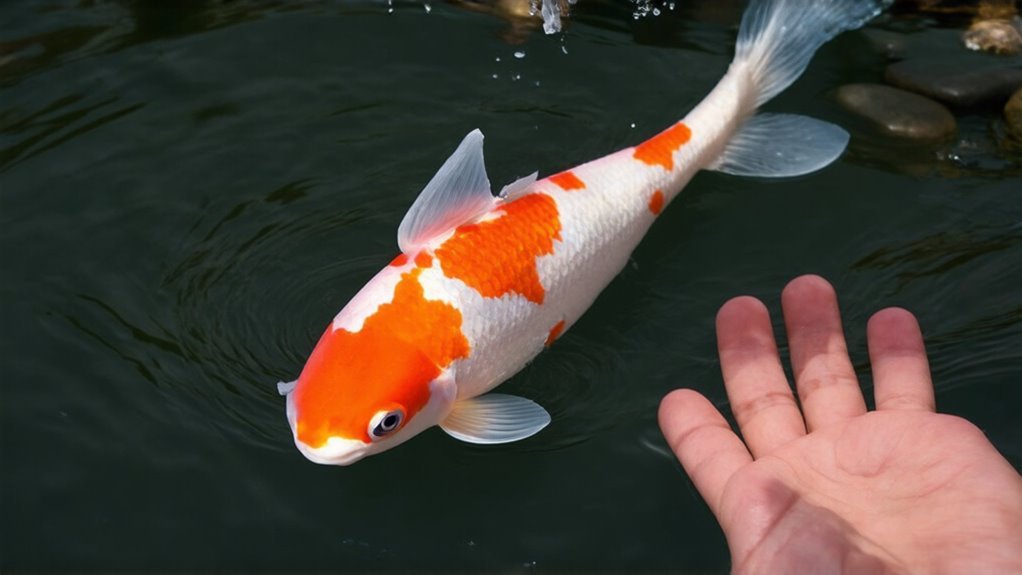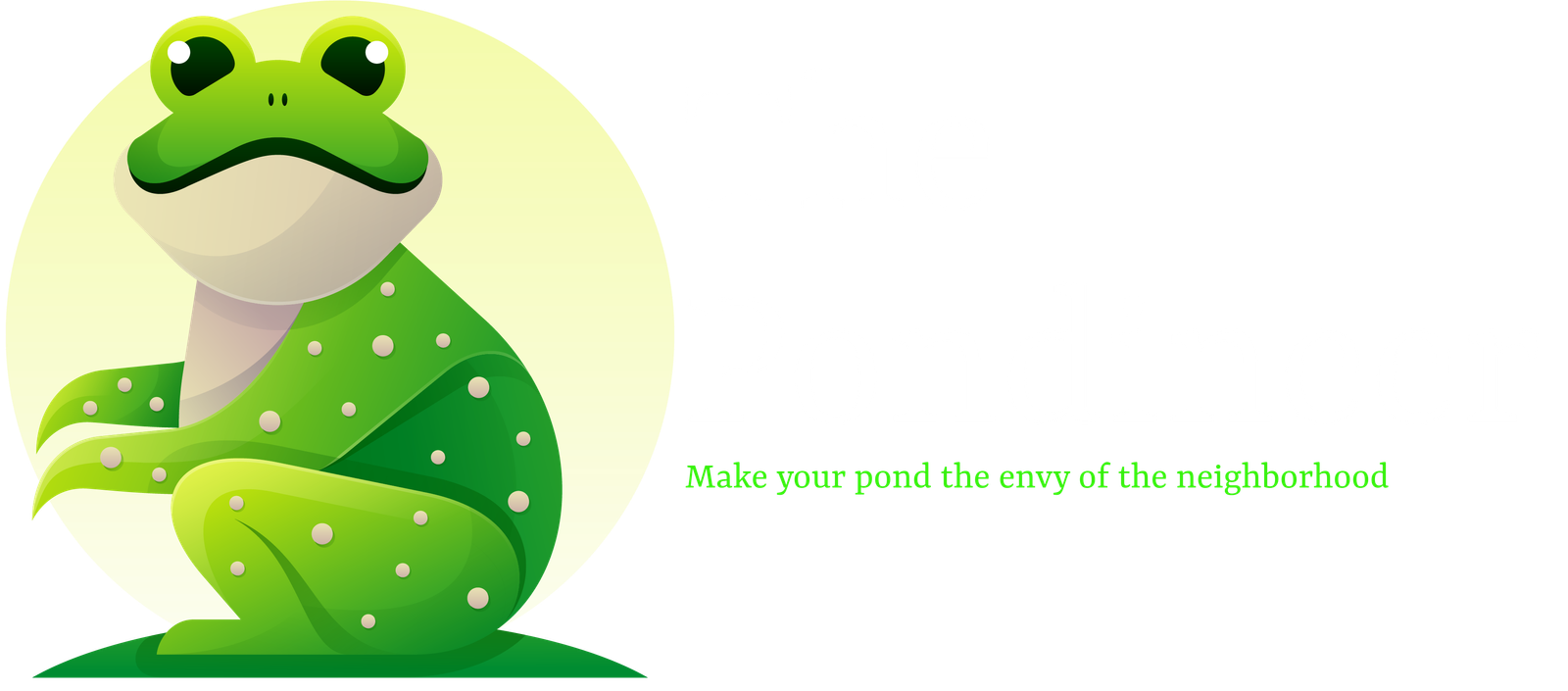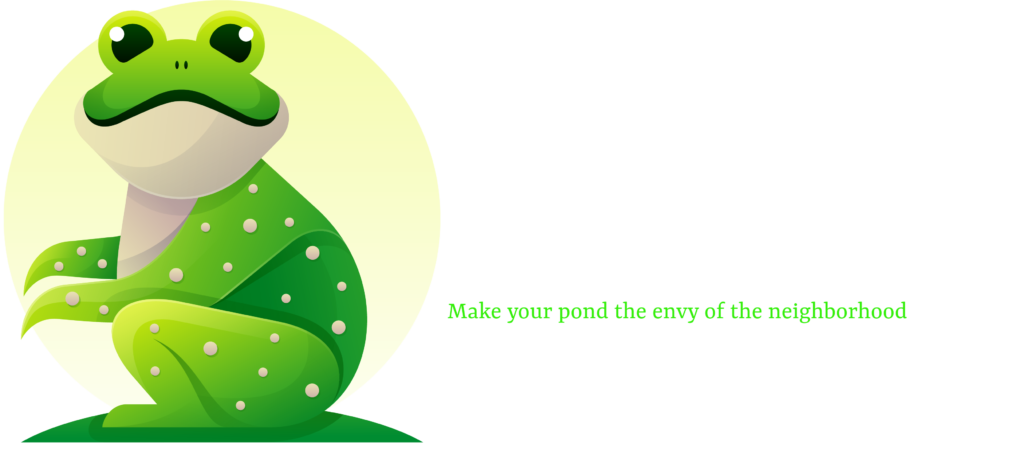Many koi enthusiasts make a critical mistake. They touch their fish. This disrupts the protective slime coat that shields koi from disease. Human hands carry oils, bacteria, and chemicals hostile to fish. The trauma doesn’t end at physical damage. Even gentle handling triggers stress responses that compromise immune function. The fish appears fine today, but infection sets in tomorrow. Yet owners can still build meaningful connections with their koi without direct contact.
The Protective Slime Coat: Nature’s Shield Against Disease

While koi fish may appear hardy in their ornamental ponds, their survival depends on an invisible barrier covering their entire bodies. This mucous membrane, known as the slime coat, functions as the first line of defense against waterborne pathogens.
When humans touch koi, their hands can strip away portions of this protective barrier, leaving fish vulnerable to bacterial infections and parasites.
The slime coat takes time to regenerate, during which the koi remains exposed to environmental threats. Even clean hands carry oils and residues that damage this critical protective layer, compromising the fish’s natural immunity. Maintaining good water quality is essential to support the health and resilience of koi during this vulnerable period.
Physical Trauma: How Human Touch Can Harm Delicate Fins

Grabbing or squeezing a koi’s fins can cause immediate tissue damage. The delicate membrane structure of fins tears easily under human touch impact. Even gentle handling risks micro-tears invisible to the naked eye, creating entry points for pathogens.
Experienced handlers recognize that fin damage often manifests days after contact.
Damage to koi fins often emerges slowly, revealing its true extent long after human hands have departed.
- Blood vessels breaking beneath translucent fin tissue, leaving dark streaks like ink in water
- Fin edges fraying like worn silk, gradually receding toward the body
- Once-proud dorsal fin folding sideways against scales, unable to provide balance
Proper technique requires minimal contact. Let the water support the fish’s weight whenever handling becomes necessary. Maintaining clean water is crucial for preventing infections that can arise from fin damage.
Bacterial Transfer: The Invisible Threat on Your Hands

Even the cleanest human hands harbor millions of microorganisms invisible to the naked eye.
These bacteria, harmless to humans, can devastate koi immune systems when transferred through touch.
Bacterial transmission occurs instantly upon contact. The microbes bypass the protective slime coat, creating entry points for pathogens.
Kois’ delicate systems lack defenses against human-specific bacteria.
Proper hand hygiene remains essential before any pond interaction.
Thorough washing with non-residue soap reduces risk. Some pathogens persist despite cleaning.
When bacterial transfer occurs, infections develop quickly in these sensitive fish.
Their recovery requires immediate intervention and specialized treatment.
Prevention outweighs cure in this delicate relationship. Maintaining optimal water conditions is also critical to reducing stress on koi and preventing further health issues.
Stress Responses: When Handling Becomes Harmful
Physical contact with koi triggers immediate physiological stress responses. Improper handling techniques cause koi to display frantic swimming patterns, darting away from human contact. Their gills pump faster, consuming oxygen at unsustainable rates. Prolonged stress weakens immune systems, opening pathways to disease.
- A once-vibrant koi hanging motionless near the pond bottom, fins clamped tight against the body
- Normally social fish isolating themselves from the group after handling
- Distinctive color fading across scales, losing brilliance as stress hormones flood the system
Observing natural koi behavior provides clear indicators of their comfort level. When fish retreat or refuse food after contact, they’re communicating distress. Additionally, monitoring fish behavior is essential for early detection of stress and potential health issues.
Safe Interaction Practices: Building Trust Without Touching
Building trust with koi requires patience rather than physical contact. Owners establish relationships through consistent presence at the pond’s edge. Koi recognize routine and associate caretakers with feeding times.
| Interaction Method | Trust Building Level | Stress Level |
|---|---|---|
| Hand feeding | High | Low |
| Shadow casting | Medium | Very low |
| Surface tapping | Medium | Low |
| Voice recognition | Medium-high | None |
| Regular schedules | High | None |
Safe feeding techniques include floating food rings that concentrate activity without handling. Successful trust building shows in koi swimming toward you rather than away. They’ll break the surface waiting, their orange and white faces expectant. Understanding seasonal fish feeding is crucial for maintaining their health and happiness.
Frequently Asked Questions
Can Koi Recognize Their Owners Through Touch?
Koi can develop owner recognition through consistent touch behavior. Their social intelligence enables them to form an owner bond through repeated positive interactions, distinguishing familiar handlers from strangers.
Will Koi Develop Different Personalities Based on Handling Frequency?
Like chameleons adapting to their environment, koi do develop distinct personalities influenced by handling frequency. Regular interaction typically produces more sociable fish, while limited handling may result in more cautious behavioral changes.
At What Water Temperature Is Touching Koi Most Harmful?
Koi are most vulnerable to handling at temperature extremes – below 50°F when metabolism slows, and above 80°F when oxygen levels decrease. Both conditions exacerbate koi stress from physical contact.
Do Elderly Koi Require Different Handling Approaches Than Younger Ones?
Walking on eggshells becomes essential with elderly koi care. Senior koi require gentler handling techniques, slower approaches, and minimal stress exposure due to their reduced resilience and slower recovery compared to younger specimens.
Can Koi Be Trained to Accept Specific Touching Routines?
Koi can be conditioned to accept routine touching techniques through consistent interaction. Their adaptive behavior allows them to become comfortable with gentle handling when paired with positive experiences like feeding.

